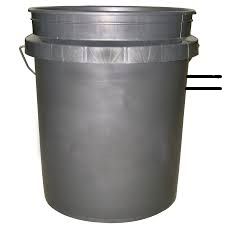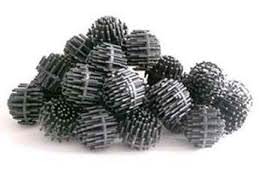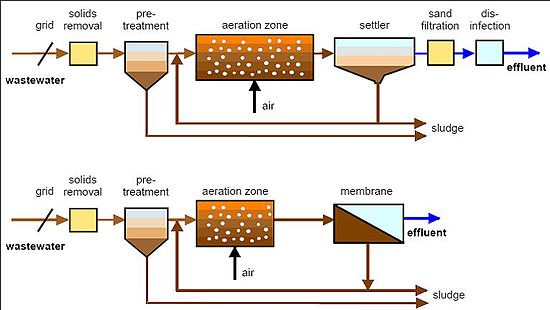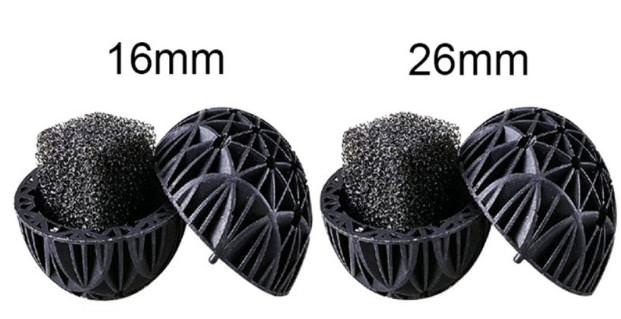JohnHuff
I know nothing.
- Joined
- Apr 17, 2012
- Messages
- 2,257
- Reaction score
- 1,621
- Location
- At my computer
- Hardiness Zone
- 1a
- Country

This is what I have for my pond right now. A biofilter doesn't have to be store bought, be very complicated or cost a lot of money. It only has to have 3 things: have good water flow, lots of surface area and lots of air.
Mine just has 2 components: a bucket and bioballs but it fulfills all the requirements of a good biofilter.
1) A container: just a 5 gallon bucket from Lowes. I've left it outside in freezing temperatures and it hasn't cracked yet. I think the Sun is probably more damaging but it's more or less covered from the sun.

2) Bioballs: These are cheap and you can get them from ebay, aliexpress or Amazon.

3) So what I do is drill a large hole about 3/4 of the way up and insert a pipe. The pipe is the outlet and drains back into the pond. I fill the bucket with water and then throw in the bioballs. The amount of bioballs determine your filtration capacity because it's the surface area of the bioballs that holds the beneficial bacteria. You can use any kind of floating media.
4) Water from the pond is pumped to the top of the bucket. I angle the incoming water so that it creates a swirl and splashes into the bucket. That does two things: it creates movement of the bioballs and the entry of the water creates a lot of bubbles. I at first thought I should put in an airstone at the bottom of the bucket but I think the splashing of the water aerates it enough.
Cons:
1) A 5g bucket isn't going to work for big ponds but it's good enough for my 700g pond with about 20 small fish in it. You could use a bigger container and more balls for a bigger pond.
2) There's a limit to how many bioballs you can have in the bucket. Too many and the bioballs won't get enough circulation. They'll just bunch up or don't move enough. Too little and there isn't enough surface area, but a 5g bucket holds quite a lot. And you can throw in media of a different shape so they mix better. RIght now I have more than a gallon's worth of balls and they move around quite well.
Pros:
1) No maintenance is needed, the bioballs don't get clogged up. When it gets too cold, I switch the main pump off and I rinse everything out at the beginning of the next season when I restart it.
2) The bucket of bioballs is a moving bed filter and provides the 3 things that a biofilter needs: good circulation from the water splashing in so the N compounds can get to the bacteria, good aeration because of the bubbles for the aerobic bacteria and lots of surface area for lots of bacteria,
What this isn't and doesn't have is mechanical filtration. I have both pre and post pump filter pads/mats for that. I used to only have pre-pump filter pads but I found that solids would still get through so now I have filter pads that also catch solids from the outlet. But the water that goes in the bucket is clean enough that it doesn't clog up the bioballs.
In essence this bucket is just the bio-filtration part of the system. You can add buckets before and/or after with settling tanks or filter pads or even more bioballs. You can go crazy and create a wastewater type of system. My current setup is just a dollar store version of this with the centerpiece and filter pads before and after the bucket.

My pet peeve is being forced to clean the filter pads to the pump when those get clogged up. And I have to do that because clogged pads hurt the pump (I can't remember if clogged water inflow or outflow hurts the pump more). So every time when I notice the water flow decrease I have to rinse out the pads and I have to do that very frequently during the active season (and not at all during winter).
But eventually (maybe next season), I'm going to alter the pathway of the water so that I won't need to change the filter pads until I want to.
Mine just has 2 components: a bucket and bioballs but it fulfills all the requirements of a good biofilter.
1) A container: just a 5 gallon bucket from Lowes. I've left it outside in freezing temperatures and it hasn't cracked yet. I think the Sun is probably more damaging but it's more or less covered from the sun.

2) Bioballs: These are cheap and you can get them from ebay, aliexpress or Amazon.

3) So what I do is drill a large hole about 3/4 of the way up and insert a pipe. The pipe is the outlet and drains back into the pond. I fill the bucket with water and then throw in the bioballs. The amount of bioballs determine your filtration capacity because it's the surface area of the bioballs that holds the beneficial bacteria. You can use any kind of floating media.
4) Water from the pond is pumped to the top of the bucket. I angle the incoming water so that it creates a swirl and splashes into the bucket. That does two things: it creates movement of the bioballs and the entry of the water creates a lot of bubbles. I at first thought I should put in an airstone at the bottom of the bucket but I think the splashing of the water aerates it enough.
Cons:
1) A 5g bucket isn't going to work for big ponds but it's good enough for my 700g pond with about 20 small fish in it. You could use a bigger container and more balls for a bigger pond.
2) There's a limit to how many bioballs you can have in the bucket. Too many and the bioballs won't get enough circulation. They'll just bunch up or don't move enough. Too little and there isn't enough surface area, but a 5g bucket holds quite a lot. And you can throw in media of a different shape so they mix better. RIght now I have more than a gallon's worth of balls and they move around quite well.
Pros:
1) No maintenance is needed, the bioballs don't get clogged up. When it gets too cold, I switch the main pump off and I rinse everything out at the beginning of the next season when I restart it.
2) The bucket of bioballs is a moving bed filter and provides the 3 things that a biofilter needs: good circulation from the water splashing in so the N compounds can get to the bacteria, good aeration because of the bubbles for the aerobic bacteria and lots of surface area for lots of bacteria,
What this isn't and doesn't have is mechanical filtration. I have both pre and post pump filter pads/mats for that. I used to only have pre-pump filter pads but I found that solids would still get through so now I have filter pads that also catch solids from the outlet. But the water that goes in the bucket is clean enough that it doesn't clog up the bioballs.
In essence this bucket is just the bio-filtration part of the system. You can add buckets before and/or after with settling tanks or filter pads or even more bioballs. You can go crazy and create a wastewater type of system. My current setup is just a dollar store version of this with the centerpiece and filter pads before and after the bucket.

My pet peeve is being forced to clean the filter pads to the pump when those get clogged up. And I have to do that because clogged pads hurt the pump (I can't remember if clogged water inflow or outflow hurts the pump more). So every time when I notice the water flow decrease I have to rinse out the pads and I have to do that very frequently during the active season (and not at all during winter).
But eventually (maybe next season), I'm going to alter the pathway of the water so that I won't need to change the filter pads until I want to.
Last edited:


